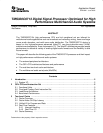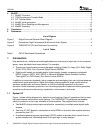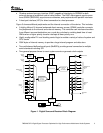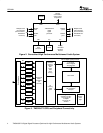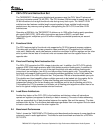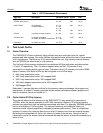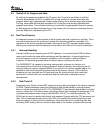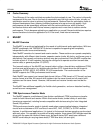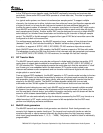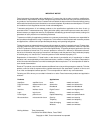
SPRA921
10 TMS320C6713 Digital Signal Processor Optimized for High Performance Multichannel Audio Systems
A typical usage for the frame sync pins is to carry the left-right clock (LRCLK) signal when
transmitting and receiving stereo data. The frame sync signals are individually programmable for
either internal or external generation, either bit or slot length, and either rising or falling edge
polarity.
Some examples of the things that a system designer can use the McASP clocking flexibility for
are:
• Input a high-frequency master clock (for example, 512fs of the receiver), receive with an
internally generated bit clock ratio of /8, while transmitting with an internally generated bit
clock ratio of /4 or /2. (An example application would be to receive data from a DVD at 48
kHz but output up-sampled or decoded audio at 96 kHz or 192 kHz.)
• Transmit/receive data based one sample rate (for example, 44.1 kHz) using McASP0 while
transmitting and receiving at a different sample rate (for example, 48 kHz) on McASP1.
• Use the DSP’s on-board AUXCLK to supply the system clock when the input source is an
A/D converter.
4.5 McASP Error Handling and Management
To support the design of a robust audio system, the McASP module includes error-checking
capability for the serial protocol, data underrun, and data overrun. In addition, each McASP
includes a timer that continually measures the high-frequency master clock every 32-SYSCLK2
clock cycles. The timer value can be read to get a measurement of the high-frequency master
clock frequency and has a min-max range setting that can raise an error flag if the
high-frequency master clock goes out of a specified range.
Upon the detection of any one or more of the above errors (software selectable), or the
assertion of the AMUTE_IN pin, the AMUTE output pin may be asserted to a high or low level
(selectable) to immediately mute the audio output. In addition, an interrupt may be generated if
enabled based on any one or more of the error sources.
4.6 McASP Summary
The two McASPs on the TMS3206713 provide a total of 16 serial lines, independently
programmable as transmit or receive. Each McASP has highly flexible independent clock and
frame control for its receive and transmit group. Each serial line in turn supports multichannels of
TDM data or alternatively direct interface to a variety of digital serial audio data transfer
standards. The McASP enables a variety of serial audio interfaces needed in the breadth of
high-performance multichannel audio applications.
5 Conclusion
The TMS320C6713 peripheral set enables the device to directly interface to a variety of
components in these systems. The McASPs provide highly-flexible direct interconnect to the
digital audio streams as well as high performance audio data converters. The two-level cache
enables efficient data management and real time I/O while hiding performance issues
associated with low cost external SDRAM. The TMS320C6713 DSP device architecture is
ideally suited for multichannel, high-performance audio applications.



